|
|
GIZE, STONEHENGE, CHICHEN ITZA, ETC,ETC: EL NILO DECODIFICADO
Elegir otro panel de mensajes |
|
|
The Nile Decoded
Revealing the Secret Message of
the World’s Longest River
By Goro Adachi
Copyright © 2003 Goro Adachi
All rights reserved.
August 9, 2003
Page 1 | 2 | 3
Introduction
What lies at the core of the ‘Time River Theory’ is more than just a theory, but a factual ‘smoking gun’ capable of utterly decimating what is being passed off as ‘reality’ today. The Time River Theory is undoubtedly an ‘extraordinary claim’. But it is one that is supported by ‘extraordinary evidence’. Indeed, it is this author’s position that the discovery of the Time Rivers heralds the last tick of the ‘time bomb’ that ends the illusion of the ‘Matrix’, so to speak. The new reality lets us discern who we really are, where we came from, and where we are going.
The Time River Theory primarily involves two ancient river systems: the Nile in Africa and the Tigris-Euphrates in the land of Mesopotamia. By the end of this paper, the reader will come to understand the explosive implication of the strange configuration depicted in the image right – that our planet’s major rivers have been intelligently designed. It would represent the closest thing mankind has seen to the ‘fingerprints of the gods’.
The strength of the theory lies in the fact that its basic claim can be presented concisely and understood by the average people without much difficulty. It is the unusual combination of clarity and seeming impossibility that makes this ‘extraordinary claim’ extraordinarily plausible, if not undeniable. It would ultimately come down to the question: ‘Do you believe your own eyes or not?’
It is of course ridiculous to think that major rivers such as the Nile are intelligently created ‘monuments’ bearing encoded messages. But that is exactly what is logically demanded by the body of evidence presented in this paper.
The Nile or denial – that may already be the real issue.
Having expressed the level of confidence, the author would like to sincerely encourage all to critically examine the following discussion, designed to present a key portion of the Time River Theory.
For a complete presentation of the wide-ranging theory and its unsettling implications for our own time, please see the book The Time Rivers (2003) by the author.
Hints of Intelligent Design
Shown below is an overview map of the Nile in Africa, the world’s longest river. This is the ancient river that gave rise to the mysterious ancient Egyptian civilization thousands of years ago.
And here are the initial clues hinting at the existence of intelligence behind the river’s layout:
-
The Nile is distinctively vertical (longitudinal), and it is the only notable river on this planet to flow directly northward.
-
The Nile begins at the equator and disintegrates precisely at 30°N latitude, marked by Egypt’s capital Cairo and Giza, the home of the great pyramids and the Sphinx.[1]
-
The generally straight Nile makes a dramatic turn southward near the halfway point. The northern peak of this remarkable bend – sometimes referred to as the ‘Great Bend’ – pinpoints latitude 19.5°N.
The significance of #3 comes from the fact that 19.5° is considered a ‘tetrahedral constant’, deriving from the geometric configuration of a circumscribed tetrahedron shown below.
In terms of the ‘hyperdimensional physics’ model promoted by researcher Richard Hoagland, well known for his investigation into the ‘monuments of Mars’, the angle even represents an inter-dimensional ‘gateway’ of some sort. This notion is echoed by the great pyramids at Giza - a place traditionally signifying a 'gateway' (Rostau) - in that their layout prominently produces this very angle.
The fact that the longitude pinpointed by the same Bend’s peak is 33.0°E intensifies our curiosity as ‘33’ too happens to be a key number detected by Hoagland’s team (The Enterprise Mission).
Indeed, 19.5 and 33 are said to be the two ‘ritual numbers’ repeatedly encoded into various aspects of NASA space missions.
In 1997, for example, the Pathfinder space probe landed on Mars at almost exactly 19.5°N. 33°W. That this was no coincidence is evidenced by the fact that: 1) the lander dropped on the ‘tetrahedral latitude’ was tetrahedral in shape; and 2) at the moment of touchdown, Earth was positioned 19.5° above the eastern Martian horizon as seen from the landing site.
As Mike Bara, Hoagland’s right-hand man at the Enterprise Mission, wrote:
Pathfinder’s unique tetrahedral spacecraft design geometry, coupled with the totally “recursive” tetrahedral geometry of the landing site itself, was obviously intended by NASA “ritualists” behind the scenes to celebrate – on their first return to Mars in over twenty years – the two key Hyperdimensional numbers underlying all the NASA rituals – “19.5” and “33.”[2]
Whether or not NASA intentionally conducts such ‘rituals’ is still a contentious issue, of course. But the coincidence of the two numbers is difficult to ignore. Where there is smoke, as they say, there is usually fire.
So how should we interpret these geographical hints provided by the Nile? Are we to believe that the Nile is a 'monument' carrying some sort of message?
While admittedly a wild speculation, this is certainly not the first time such an idea has been put forward. There is, for example, researcher Livio Catullo Stecchini, whose view is presented in Peter Tompkin’s Secrets of the Great Pyramid:
The Egyptians were proud that their country had some unique geographic features which could be expressed in rigorous geometric terms and had a shape which related to the order of the cosmos as they saw it. They believed that when the gods created the cosmos they began by building Egypt and, having created it perfect, modeled the rest around it. …[The] Egyptians put great stress also on the geographic peculiarities of the course of the Nile.[3]
So the question is: Are these Nilotic ‘peculiarities’ a result of some deliberate design? Did the ‘gods’ literally construct the Nile and encode into its layout their cosmic knowledge?
Throughout history much has been said about ancient monuments - such as those at Giza (the pyramids and Sphinx) - bearing very advanced knowledge surpassing all that came afterward. It is of course a controversial view that many find uncomfortable. But it pales in comparison to the much crazier possibility emerging here... that the world’s longest river, clearly visible from space, may be a gigantic ‘monument’!
A Literal ‘River of Time’?
Suspending our disbelief for a moment, let us ponder just what the encoded ‘cosmic knowledge’ may be. What kind of information could be so important as to be transmitted this way?
This question leads us to the next clue.
As noted earlier, the latitudinal length of the Nile is almost exactly 30 degrees. The number ‘30’ happens to be closely attached to the notion of time:
- Saturn, traditionally considered the god/planet of time, has an orbital period of ~30 years.[4]
- One month – the Moon’s orbit around Earth – is approximately 30 days. (In ancient Egypt, each month was exactly 30 days.)
- The apparent path of the sun in the sky (the ecliptic) is traditionally divided into twelve zodiacal ‘signs’ (Pisces, Aires, Taurus, etc.), 30 degrees each, corresponding to the sun’s movement in two hours. (The Babylonians, the Chinese, etc. actually divided the day into not 24 but 12 equal parts, and so one subdivision of the day corresponded to 30 degrees [i.e. 360/12=30].)
- The seb festival of the ancient Egyptians, commemorating the symbolic death/renewal of the king, was held in the 30th year of the reign.[5]
So the implication here is that the Nile is to be viewed as a ‘river of time’. This is poetically appealing at least. After all, it is often said that ‘a river is like the flow of time’.[6]
The above interpretation is reinforced by certain information transmitted by Plutarch, a renowned Greek writer and biographer from around AD 100. It concerns Saturn, the god of time, who was called ‘Cronus’ in Greek (related to the term ‘Chronos’ meaning ‘time’[7]):
There is also a religious lament sung over Cronus. The lament is for him that is born in the regions of the left, and suffers dissolution in the regions on the right; for the Egyptians believe that the eastern regions are the face of the world, the northern the right, and the southern to the left. The Nile, therefore, which runs from the south and is swallowed up by the sea in the north, is naturally said to have its birth on the left and its dissolution on the right.[8]
Not only does Plutarch reveal here that Cronus/time arises in the south and ends in the north just like the Nile, he even goes on to draw a direct parallel between Cronus/time and the Nile! This is almost an open and direct acknowledgement that the Nile may indeed represent the flow of time.
God of Time, God of the Nile
Another telling clue is found in the fact that various mythological gods associated with time are also often associated with the Nile. For instance:
- Cronus-Saturn’s otherworldly domain called Ogygia is applicable to the Nile since the river was similarly called ‘Ogygian’ by the ancient Greek writer Aeschylus.[9]
- The Moon, associated with the ‘temporal number’ 30 via its orbital period (30 days), is traditionally identified with the Egyptian god of wisdom called Thoth. Not only was Thoth considered the measurer of time, he was also represented by the ibis, an animal closely associated with the Nile.[10]
More striking is Osiris, the most revered and complex deity in ancient Egypt, popularly described as the god of the dead.
Osiris is quite simply the ‘god of the Nile’. This can be established through his traditional identification with Apis and Hapi, both considered to embody the Nile. Osiris was also known as Serapis, a name deriving from Ausar-Hapi, meaning ‘Osiris of the Nile’. We also have Herodotus’ well-known statement: ‘the Nile is the gift of Osiris, but Egypt is the gift of the Nile’.
And we find that Osiris, the god of the Nile, is also a god of time not unlike Saturn. Osiris was identified with the phoenix, the mythical fire-bird of cyclical rebirth and the patron of all time division.[11] In the ancient Egyptian Book of the Dead is found the statement: ‘I am Time and Osiris’.[12] And in ancient India the name given to Orion (the celestial form of Osiris) was Kal-Purush, or ‘Time Man’.[13]
To all intents and purposes, Osiris is the Egyptian version of Cronus-Saturn, the god of time.[14] In confirmation of this, historical epithets of Orion (= Osiris) include ‘Saturnus’ – i.e. Saturn.[15]
So, at least mythologically, the Nile-time connection is well supported.
Go to Page 2 (of 3)
|
|
|
|
|
The Nile Decoded
Revealing the Secret Message of
the World’s Longest River
By Goro Adachi
Copyright © 2003 Goro Adachi
All rights reserved.
August 9, 2003
Page 1 | 2 | 3
...continued from Page 1
Giza Producing ‘Anchor Dates’
If the Nile really is a literal river of time – a ‘Time River’ – then the possibility must be considered that there is a tangible timeline encoded into its design. And it can be reasonably assumed that the river’s beginning point at the equator represents the earliest point on the timeline, and Giza/Cairo at the edge (30°N) the ‘end of time’. (See Appendix 1 for discussion on the beginning latitude of the Nile.)
The most sensible time-encoding system here would be one based on latitude, where a linear, northward-moving timeline is superimpose on the Nile.
To derive a timeline in this system, it is necessary to first have at least two ‘anchor points’, or 'anchor dates', placed upon the Nile. The rest would be just a matter of simple calculation. (The distance between the two anchor points will have the function of a base unit for the timeline.) But there needs to be a good rationale for selecting these points/dates.
For this, we turn to the Giza monuments, evidently an integral part of the Nile scheme (marking the river’s northern edge). Giza, through its astronomical alignments, manages to give us just what we need to turn the ancient river into a tangible map of time.
The key here is Robert Bauval’s popular ‘Orion Correlation Theory’ (or more broadly the ‘Star Correlation Theory’) which traces the Giza layout back to the stars. The basic idea is quite simple. The theory essentially says that the arrangement of the three great pyramids standing there closely emulates that of the three Belt Stars of Orion, the heavenly Osiris.
Bauval demonstrates this first by noting that the smallest pyramid is slightly offset from the diagonal line made by the other two pyramids. He then compares this to a similar offset seen in the Orion Belt Stars, with the dimmest star congruently corresponding to the smallest pyramid.
This sky-ground correspondence is supported by a passage from the ancient Egyptian ‘Pyramid Texts’ which makes it plain that the pyramid and Osiris-Orion are closely linked:
O Horus, this King is Osiris [= Orion], this pyramid of the King is Osiris, this construction of his is Osiris; betake yourself to it, do not be far from it in its name of ‘Pyramid’…[16]
Next, based on this initial ‘as above, so below’ connection, Bauval points out that there was an extraordinary set of alignments around 10,500 BC:
Around 10,500 BC:
- Orion reached its lowest point at the meridian in its 26,000-year precessional cycle. (Precession slowly shifts Orion and other stars up and down the meridian, the imaginary north-south line drawn in the sky where the stars achieve their highest daily altitudes.)
- On the vernal equinox, the Great Sphinx, directly facing east, witnessed the rising of its two celestial counterparts – the sun and Leo.
At the moment of equinoctial sunrise (c. 10,500 BC):
-
Orion was positioned right at the meridian.
-
In the southern sky, the Milky Way was seen roughly vertical and positioned in such a way that it appeared to be an extension of the Nile. Orion was situated just to the right of the celestial river – closely mimicking the configuration of the Giza pyramids and the Nile.
It is reasonable to conclude that the builders of the Giza monuments intended to commemorate the extremely ancient epoch of 10,500 BC.
We can refine the date by taking a closer look at Point #1, i.e. Orion’s lowest transit point (‘southern culmination’). It occurred more exactly c. 10,600 BC. This, then, is our first ‘anchor date’.
As for the second ‘anchor date’, the answer turns out to be the ‘Pyramid Age’ when the pyramids themselves were built - around 2500 BC.
The date can be refined through another Giza celestial alignment, this time involving the four ‘air shafts’ (or 'star shafts') emanating from the so-called King’s Chamber and Queen’s Chamber inside the Great Pyramid.
Expanding on the theory of Alexander Badawy and Virginia Trimble,[17] Bauval found that these shafts, targeted at the meridian (i.e. due south/north), are angled just right so that around 2400 BC they aligned with key stars crossing the meridian ('transit'). The southern shafts were aimed at Alnitak (of Orion) and Sirius; the northern ones were aimed at Beta Ursa Minor (‘Kochab’) and Alpha Draconis (‘Thuban’, the ancient Pole Star).
Bauval claims that these alignments collectively pinpoint c. 2450 BC, but this is not quite accurate. It should be more like c. 2350 BC. All the star-shaft alignments occurred at the latter time except for Orion’s alignment with the King’s Chamber southern shaft (c. 2490 BC). But as Dr. Thomas G. Brophy points out, the same shaft did come into alignment with the Galactic Center around 2350 BC.[18]
At this point, then, the Giza monuments have given us two solid anchor dates, 10,600 BC and 2350 BC.
A Timeline Emerges
The next step is to figure out where to place these anchor dates along the Nile.
For 10,600 BC, it is actually a simple matter. Since the ‘10,500 BC epoch’ appears to signify the mythical ‘First Time’ (Zep Tepi), as postulated by Bauval and Hancock, it would naturally go to the source of the Nile at the equator. It is where ‘time’ begins, as the Nile flows out of Lake Victoria. In support of this designation, we find that the same epoch also happens to mark the establishment of the Nile’s equatorial Lake Victoria outlet.[19]
Additionally, the usage of the equator as the beginning latitude is strongly encouraged by Giza’s 10,600 BC celestial alignment. Let us examine it again:
-
Orion was positioned due south and as close to the horizon as possible, thus guiding our attention toward the southernmost source of the Nile (Lake Victoria) situated due south of Giza.
-
Point 1 was accompanied by the equinoctial sunrise with Leo due east. Since the equinoxes are when the sun is at the extension of the equator (called the ‘celestial equator’), it tells us that 10,600 BC is to be seen as an equatorial (anchor) date.
As for the 2350 BC anchor date, we can assume that it will go to one of the following key points on the Nile: 1) the confluence at Khartoum, 2) the Atbara confluence, 3) the Great Bend peak, or 4) Giza/Cairo. The question is: Which one?
A big clue here comes from Sirius and Orion’s Alnitak, two prominent stars from the Great Pyramid's star-alignment scheme. They happened to produce the angle 19.5° around 2350 BC.
When Sirius was rising at the horizon as viewed from Giza, Alnitak we seen hovering 19.5° above the horizon. (See illustration below.)
This suggests that the date 2350 BC and the angle/latitude 19.5° are to be united. Hence we are encouraged to assign the second anchor date to the Great Bend’s peak at 19.5°.
There are other clues supporting the arrangement - including the fact that the general region of the Great Bend (Nubia/Kush) was once called the ‘Land of the Bow’ (Ta-Seti), which strongly resonates with the ‘Sirian’ nature of the 2350 BC-19.5°N anchor point, because Sirius’ various epithets happen to include ‘Bow Star’ (as well as ‘Arrow Star’).
So, with the two anchor points firmly established, we are now ready to move on to the critical step - the conversion of Nilotic latitudes into dates.[20]
As the highlights below show, what emerges is a startling timeline:
- Khartoum at 15.60°N. corresponds precisely to 4000 BC.
- The Atbara-Nile confluence at 17.67°N. corresponds to 3124 BC.
- Giza/Cairo at 30.00°N. corresponds to AD 2093.
For those familiar with the general outline of ancient history, the significance of the first two dates, 4000 BC and c. 3100 BC, should be immediately clear. The third date c. AD 2100 is intriguing too for its close proximity to our own time.
For those not very familiar with ancient chronology, 4000 BC is in various ways – historically, religiously, and esoterically – the ‘beginning of the world’:
- It was around 4000 BC that the first known high civilization called Sumer suddenly rose in Mesopotamia (present Iraq) to begin ‘history’.
- The year 4004 BC is the standard Christian date for Adam, the first man, based on the scriptural calculation done by Archbishop James Ussher in the mid-seventeenth century (Annales Veteris Testamenti). In his calculation, Ussher even applied the date 2348 BC to the Great Flood, which almost exactly matches one of our anchor dates (2350 BC)!
- 4000 BC is the beginning date used in the calendar adopted by Freemasonry – a quasi-esoteric fraternal organization whose enigmatic tradition can be traced back to various ancient cultures, including ancient Egypt. (Remarkably, the highest rank in Scottish Freemasonry is called ‘33rd Degree’ as if in reference to the key Nilotic longitude, 33°E.)
The other ancient date pinpointed, c. 3100 BC, has similar implications:
- The date coincides with the beginning of ancient Egypt – none other than the ‘gift of the Nile’ itself! It was indeed around 3100 BC that King Menes commenced the Dynastic period as he unified Lower Egypt and Upper Egypt – an event known as the ‘Unification of the Two Lands’.
- The date coincides with what the Mayan calendar calls the ‘Birth of Venus’ (3114 BC), the beginning of the current age.[21]
- For the Hindus, too, c. 3100 BC was the beginning of the present age called Kali Yuga.[22]
It is quite evident that the Nile Timeline is very meaningful.
Now, before moving on to the next step, let us divide up the Nile according to the zodiacal Ages, each lasting roughly 2160 years. (We are currently living near the end of the 'Age of Pisces' and about to move into the 'Age of Aquarius'.) The illustration below shows the Nile so rendered.
We see that the river covers exactly six Ages – Leo, Cancer, Gemini, Taurus, Aries, and Pisces. Notice that the middle section around the Great Bend corresponds to the Age of Taurus. This will be shown to have a profound implication shortly.
Go to Page 3
|
|
|
|
|
EL RIO NILO DECODIFICADO POR GORO ADACHI EN ESPAÑOL
|
|
|
|
|

by Goro Adachi
May 19, 2003
from Etemenanki Website
House of God
At the heart of the 'Time River scheme' is the 'Great Bend' of the Nile. It is intimately associated with the 'gifts', the flood, and Eden. Egyptologists have long thought the 'Winding Waterway' mentioned often in ancient Egyptian texts was a reference to the Nile and/or the Milky Way, but it is actually more applicable to this Great Bend in particular where the generally straight river suddenly 'winds' like a snake.
This is supported by the texts connecting the Winding Waterway with 'flood', which for the Nile was caused by the 'gift rivers' (i.e. Blue Nile and Atbara connected to the Great Bend).
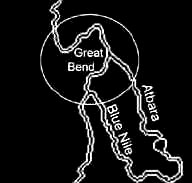
As the 'flood-heralding star', Sirius is naturally relevant to the Great Bend as well. It is certainly fitting that Sirius - like the 'gift rivers' - is often associated with the idea of a 'stargate'; after all, the pentagram (a 'stargate symbol' via the embedded phi ratio and vesica piscis) traditionally signifies 'goddess stars' such as Sirius and Venus.
In terms of Richard Hoagland's 'hyperdimensional physics' derived from the geometric 'message' of Cydonia (Mars), the conduit or 'stargate' between this world 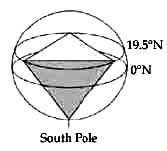 and the Otherworld (i.e. hyperspace) is prominently represented by the angle 19.5°. According to the theory, it is the tetrahedral geometry signified by this angle that enables inter-dimensional energy transfer between the two realms. and the Otherworld (i.e. hyperspace) is prominently represented by the angle 19.5°. According to the theory, it is the tetrahedral geometry signified by this angle that enables inter-dimensional energy transfer between the two realms.
 This 'stargate' geometry is expressed by a circumscribed tetrahedron (made up of four equilateral triangles). Interestingly enough, the hieroglyphic sign denoting Sirius was a triangle in ancient Egypt. This 'stargate' geometry is expressed by a circumscribed tetrahedron (made up of four equilateral triangles). Interestingly enough, the hieroglyphic sign denoting Sirius was a triangle in ancient Egypt.
The connection is made evident by archaeo-astronomy. First, it is widely accepted these days that the 'air shafts' inside the Great Pyramid were designed to aligned with certain stars. One was specifically targeted toward Sirius in c. 2350 BC.
And at that pinpointed time (c. 2350 BC), Sirius and Orion's Alnitak (representing the Great Pyramid as per the Orion Correlation Theory) together produced the angle 19.5° (when Sirius was rising on the Giza horizon).[10]
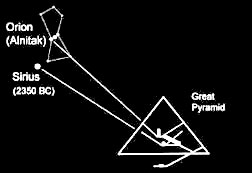 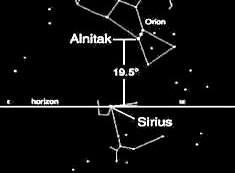
Next, it is natural - given the Sirius-Great Bend connection - to wonder about the possibility of the Nile's 'Winding Waterway' having some relevance to tetrahedral geometry. Indeed, we do find a clear connection!
Believe it or not, the northern peak of the Great Bend precisely pinpoints the tetrahedral/stargate latitude, 19.5°N.!

What's even more incredible is the fact that the same Bend peak also pinpoints 33°E longitude. As those familiar with Hoagland's work would surely know, '33' and '19.5' are considered the two key numbers in the 'hyperdimensional code'! (Hoagland is just not yet aware of this Nile connection.)
In 1997, the esoteric importance of those numbers was overtly demonstrated as NASA landed a tetrahedron-shaped Mars Pathfinder lander on the Red Planet at 19.5 N and 33 W.! (That's pretty in your face, isn't it?)
Not only that, at the moment of touchdown, Earth was positioned 19.5 degrees above the eastern Martian horizon as seen from Pathfinder's landing site.[11]
As Mike Bara, Hoagland's right-hand man at the Enterprise Mission, wrote:
Pathfinder's unique tetrahedral spacecraft design geometry, coupled with the totally "recursive" tetrahedral geometry of the landing site itself, was obviously intended by NASA "ritualists" behind the scenes to celebrate – on their first return to Mars in over twenty years – the two key Hyperdimensional numbers underlying all the NASA rituals – "19.5" and "33."
Indeed, NASA obsessively incorporates those two numbers again and again into its space missions.[12]
The implication is clear: the Great Bend, along with the entire Nile system, is a key part of the 'stargate game' - or 'Stargate Conspiracy' - and the Nile is likely an 'intelligently designed' river with a profound message concerning the Red Planet as well as reality itself.
In The Time Rivers, I further discuss how the above interpretation seems to interact harmoniously with certain ancient Egyptian art themes having to do with the Otherworld (or the 'Duat').
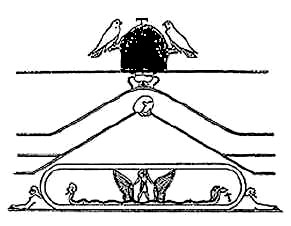 The drawing shown right, for instance, depicts a pyramidal 'mound' of the 'House of Sokar' (the 'Fifth Division of the Duat') - a form of Giza-Rostau - with a female head at the apex. While the first impression is that it is a stylized Giza pyramid, the general shape also evokes the Great Bend especially given the mutual 'stargate' connection. The drawing shown right, for instance, depicts a pyramidal 'mound' of the 'House of Sokar' (the 'Fifth Division of the Duat') - a form of Giza-Rostau - with a female head at the apex. While the first impression is that it is a stylized Giza pyramid, the general shape also evokes the Great Bend especially given the mutual 'stargate' connection.
This interpretation is strongly supported by the fact that the female head at the apex belongs to Isis (according to the accompanying text) - the goddess signified by Sirius.[13] As we have seen, the Great Bend's apex (19.5°) is similarly associated with Sirius.
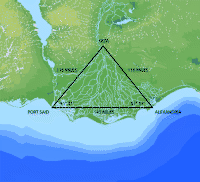 The Sirian nature of the pyramid apex reinforces the 'stargate-ness' of the Giza/30°N latitude because Giza sits at the southern apex of the triangular, or 'pyramidal', Nile Delta. The Sirian nature of the pyramid apex reinforces the 'stargate-ness' of the Giza/30°N latitude because Giza sits at the southern apex of the triangular, or 'pyramidal', Nile Delta.
Indeed, as Jim Alison has recently pointed out, the angles of the Great Pyramid almost perfectly match those made by the Delta using Giza, Alexandria, and Port Said. (click on image left.) This 'Delta pyramid' is even exactly 1000 times the size of the Great Pyramid!
Pyramid apexes were also associated with the resurrection of Osiris. As the embodiment of the phoenix, the pyramid capstone (the Benben stone) signified the god's death-rebirth cycle. And the annual Nile flood that Sirius heralded was viewed in ancient Egypt as the revitalization of Osiris.
This is very fitting, after all resurrection occurs through an inter-dimensional gateway - a stargate - separating this world and the Otherworld of the dead.
As for the strange bell-like object placed just above Isis' head in the drawing, it is usually thought to represent the Benben Stone (or the omphalos, the navel stone), which is a form of the shem ('fire-stone') associated with the Tower of Babel etc. as discussed earlier. We recall that the Tower - analogous to the Jacob's stone pillar - is a form of stargate.
Let's take another look at the Genesis passage describing the pillar-stargate of Jacob:
...How dreadful is this place! This is none other but the house of God, and this is the gate of heaven. And Jacob rose up early in the morning, and took the stone that he had put for his pillows, and set it up for a pillar, and... this stone, which I have set for a pillar, shall be God's house... [emphasis added]
Notice how the pillar-stargate is being described as the 'house of God'. This directly relates to the pyramidal 'House of Sokar' (i.e. the drawing above-right), because Sokar is an alter ego of Osiris - the most revered god of ancient Egypt.
The 'House of Sokar', in other words, is a 'House of God' and vice versa.
Hall of Records
The House of Sokar/House of God is basically another name for the 'Tomb of Osiris'. In a Gnostic context, it corresponds to the fabled 'Hall of Records' - made famous by the psychic 'readings' of Edgar Cayce, the 'Sleeping Prophet'. It is generally thought of as a 'black box' from the antediluvian world, often called 'Atlantis'. Ancient tradition concerning such a 'secret chamber' is discussed notably in Andrew Collins' Gods of Eden (1998) and more extensively in Robert Bauval's Secret Chamber (1999).
In The Stargate Conspiracy is also described the evolving interest and mythology surrounding it:
In our present fin de siecle era, a rising Hall of Records hysteria is carefully being whipped up by books, videos and the instant whispering machine of the Internet. Where is this fabled place located? What does it contain? Who will find it - and what will happen when they do? Already this has become, in every possible sense, the modern quest for the Holy Grail...
[T]he Chosen will eventually win through, and when the Grail Hall is uncovered, somehow magically the whole of our civilization will be transformed. We shall understand our past and even our future. We shall suddenly see humankind for what it is, and know the truth about the gods.[14]
The prevalent view has been that the 'secret chamber' is likely hidden underground somewhere in Giza, most notably beneath the Great Sphinx. Seemingly supportive of this suspicion is the stylized depiction of the House of Sokar (such as the one we just saw) in which twin sphinxes ('Aker') are shown guarding an underground 'chamber'.
We find a similar configuration depicted in the drawing of the Sphinx/Dream Stela placed between the paws of the Great Sphinx itself.
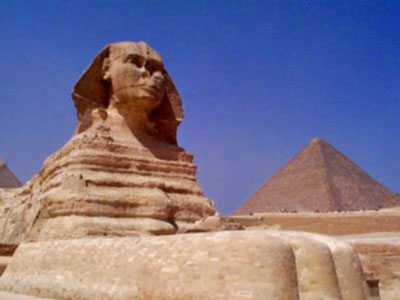
Collins writes:
Curiously enough, the relief on the Sphinx Stela set up by Thutmose IV in front of the stone monument shows him venerating the Sphinx, which appears to be resting on an underground temple or building with a large entrance door. Could this image have been alluding to some kind of hidden temple or chamber located beneath the Great Sphinx?[15]
What gets our attention here is the rectilinear pattern of the subterranean 'chamber'.
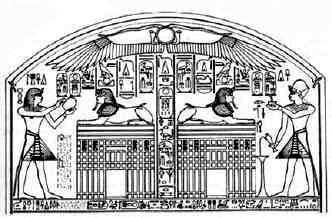
If we recall, what kick-started the Endgame series was the IR (infrared) image of Cydonia taken last year by the Odyssey spacecraft orbiting Mars. As discussed in the first Endgame article, the big controversy was that the IR photograph seemed to show a huge complex of rectangular underground 'structures' (click on image below right).
And in Endgame III I discussed how the infamous 'Face on Mars' in Cydonia was a form of the Sphinx, because the Face, if the left and right sides were mirrored, would show the head of a lion and a human body (click on image left), which is the reverse of the traditional image of the sphinx (a human head on a lion's body).
 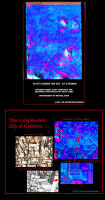
So the underground 'blockies' of Cydonia seen in the IR image are in effect situated 'under the Martian Sphinx' - thus visually and symbolically echoing the 'secret chamber' shown beneath the sphinx in the ancient drawing. In other words, in a transposed context, we may have already detected the first sign of the so-called 'Hall of Records'... under the Martian Sphinx!
The Cydonia picture controversy, if we recall, also resonates with the 'false gift' theme, in that the name 'Odyssey' (the spacecraft that took the picture) alludes to the mythological figure Odysseus in Homer's masterpiece The Odyssey who orchestrated the great deception involving the Trojan Horse - an archetypal 'false gift' - to successfully destroy Troy in the great war.
On a more exoteric level, however, the name is a reference to another masterpiece: Arthur C. Clarke's 2001: A Space Odyssey. The obvious link is that Odyssey was launched in '2001'.
The emergence of the year '2001' here is interesting, as the 2-year cycle pattern established in The Message of Cycle 23 would next point to the year 2003. The relevance of this pattern is strengthened by Mars having an approximately 2-year orbital period around the sun.

And as the projected timeline above shows, it is the time around September 2003 that specifically represents the 'echo window' of 9/11 (2001). Amazingly enough, it just happens that we will have a close encounter with the planet Mars around that time (late August); indeed, this will be the closest encounter in nearly 60,00 years!
Quite clearly, 2003 is the year of Mars. And it appears that the Martian climax this summer is somehow designed to open up a 'stargate'.
Let me mention this again: in The Stargate Conspiracy it is pointed out that the year 2003 has been singled out by an 'insiders' source (namely James Hurtak, author of Keys of Enoch) as a time of great significance.
Stargate Sequence
Speaking of 'insiders', we recall that there were some potential 'insiders' in Hoagland's Enterprise Mission forum who posted cryptic messages as if to subtly 'leak' some key information. This was something discussed in the first Endgame article.
One of the those messages was a numerical cipher posted by 'KBS', which was decoded to reveal a strange statement. Let's take a look at what I wrote about this:
The relevance of the Cydonia IR picture to this supposed crop-circle "SETI" communication has been further suggested by another strange message from 'KBS', the person who sent 'spacecatfish' the enigmatic 'llama & priests' picture. On Aug. 27, in the Enterprise Mission forum, 'KBS' posted a hyperlink to a page showing the 2002/'disk' crop formation.
The hypertext itself read:
"1101411201201710401011561161511261451621231411221710
54040110157101147154101156144"
The post was then followed by a comment from "Dr. Peter Martin":
[...] I was fascinated by your link title however:
1101411201201710401011561161511261451621231411221710
54040110157101147154101156144
As it is obviously a code of some sort and as I have considerable experience with such things in addition to my interest with the crop circle phenomena here in the UK, I thought that I'd attempt to decipher it.
Eventually I figured out how it was composed and have decoded it to read:
HaPPy AnNiVerSaRy, HoAglAnd
This was achieved by grouping 3 digits at a time working left to right and interpreting them as the octal representation of an ASCII character code. [...]
"Happy anniversary, Hoagland"? Whatever that really means, the 'insider' poster (?) 'KBS' seemed to subtly suggest that there indeed was some kind of link between the crop messages and Hoagland's work. Therefore there is now more reason to suspect that the 'false gifts'/'broken promises'/'deception' mentioned in the coded crop message had some relevance to the THEMIS IR picture, the 'gift' from the Odyssey spacecraft...
Back then I naturally assumed that the 'anniversary' reference was pertaining to some event in the past. But now I have realized that 'anniversary' - meaning' 'returning with the year, at a stated time' - could also easily point to a future time, one year ahead.
As the above message was posted last year on August 27, its 'anniversary' would point ahead to August 27, 2003. Well, let me quote from a space.com article:
"At 5:51 a.m. EDT on Aug. 27, 2003, Mars will be within 34,646,418 miles (55,758,006 kilometers) of Earth... the closest that Mars has come to our planet in nearly 60,000 years."
Yes, the historic 'close encounter of the red kind' this summer will climax exactly on the 'anniversary' date - August 27!
In hindsight, it's quite obvious that the poster 'KBS' was alluding to this future event. This is yet another clue suggesting that the '9/11 echo window' coming this summer/fall will be an important time.
And the underlying message seems to be that we are in for a 'stargate event' - whatever that may be.
There are some intriguing 'signs in the sky' as well. For instance, one of the celestial points associated with the concept of a 'stargate' is the intersection of the ecliptic (the sun's path) and the Milky Way.[16] While there are two such points, the more notable one is the intersection marking the border between the constellations Gemini and Taurus.
Its significance here derives largely from the fact that it is pinpointed by the raised arm of Orion (= Osiris; an 'stargate' constellation) as the image below illustrates.
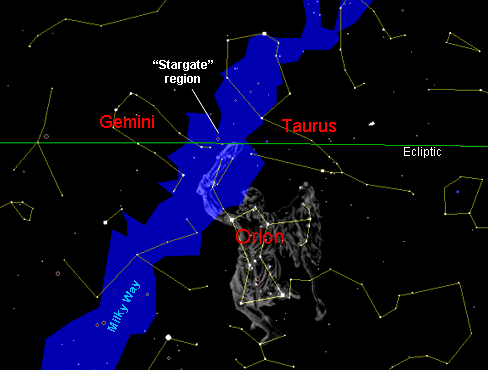
This makes us wonder if the 'stargate year' 2003 will produce a special configuration involving this particular spot in the sky. I quickly found out that this indeed was the case.
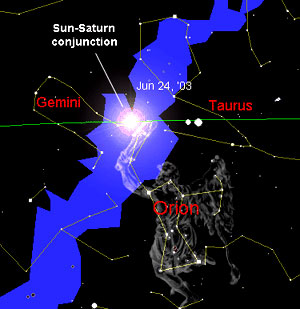 Around June, or around the summer solstice, the planet Saturn happens to be transiting this region. Saturn, the planet/god of time, is an alter ego of Orion-Osiris. Around June, or around the summer solstice, the planet Saturn happens to be transiting this region. Saturn, the planet/god of time, is an alter ego of Orion-Osiris.
And on June 24 - just 3 days after the solstice - Saturn will be united with the sun. This date pinpointed here is quite meaningful, as June 24 is the feast day of John the Baptist - a biblical figure associated in Endgame III with the 'Face on Mars', the Sphinx, the Turin Shroud, etc., thus relevant to the stargate theme. (by the way, doesn't the image shown left remind you of the Statue of Liberty?)
This is interesting enough, but there is more. Although Saturn generally moves in one direction along the ecliptic, it does (appear to) go back and forth rather frequently. This means that the planet would pass a given spot more than once in one 30-year cycle around the sun. As such, the coming 'stargate' transit near the solstice will not be the first in the current cycle of Saturn.
It was at the same spot back in the fall of 2002 - starting around the beginning of September. This was the exact time when Hoagland's analysis of the Cydonia IR picture was hitting the fan! (He released the data on Sept. 5, though the buzz was already building in August.)
Adding to this is the fact that the same configuration was repeated just recently around May 15, 2003.
Now... this is an intriguing date.
'May 15' of this year attracted a lot of attention because of the widespread rumor regarding 'Planet X' or 'Nibiru' (i.e. Zecharia Sitchin's speculative '12th Planet'), supposedly coming this way to wreak havoc on earth... around May 15, '03.
The buzz was created largely by 'Zetatalk', a lady claiming to channel gray aliens ('Zetas').
 
While I personally consider Zetatalk to be rather silly (like the Raelians), it did conceptually fit into the 'pattern' pretty well. After all, our 'alien crop glyph' featured a cartoonish 'gray'-type alien. Additionally, there have been some discussions about Nibiru actually being a reference to a stargate.
And even Iraq - a 'stargate land' - responded to this, as we were told on May 15 that the US military there executed 'Operation Planet X' (no joke). So, I'd say there was a minor 'echo effect'. It was a little 'stargate preview window'. (It's kind of interesting that I am positing this article on May 19... perhaps part of the pattern as well? That would be just... weird.)
If the pattern continues, we should see a similar but more amplified 'echo' on/around June 24 - beginning the process of 'stargate activation'.
And it is of course during the climax window around September that we will see a special 'convergence' that is likely to produce some kind of major stargate event.
Go to Part 3 →
References
[10] Atmospheric refraction taken into account; Adachi, The Time Rivers, pp.42, 65.
[11] See Michael Bara and Richard C. Hoagland, “Table of ‘Coincidence’: A Guide to the Improbable at NASA and in History”
[12] Mary Anne Weaver, "Investigation into the Enterprise Mission's Proposition that the 19.5 and 33.0 Degree Star Alignments Constitute a Pattern," www.angelfire.com/ca3/citystars/
[13] Mark Lehner, The Complete Pyramids (New York: Thames and Hudson, 1997), p.30.
[14] Picknett and Prince, The Stargate Conspiracy, pp.58-9.
[15] Andrew Collins, Gods of Eden (London: Headline Book Publishing, 1998), p.185.
[16] Giorgio de Santillana and Hertha von Dechend, Hamlet's Mill (Boston: David R. Godine, 1977), pp.63, 258.
|
|
|
|
|
by Goro Adachi
August 9, 2003
from Etemenanki Website
Introduction
What lies at the core of the ‘Time River Theory’ is more than just a theory, but a factual ‘smoking gun’ capable of utterly decimating what is being passed off as ‘reality’ today. The Time River Theory is undoubtedly an ‘extraordinary claim’.
But it is one that is supported by ‘extraordinary evidence’. Indeed, it is this author’s position that the discovery of the Time Rivers heralds the last tick of the ‘time bomb’ that ends the illusion of the ‘Matrix’, so to speak. The new reality lets us discern who we really are, where we came from, and where we are going.
The Time River Theory primarily involves two ancient river systems: the Nile in Africa and the Tigris-Euphrates in the land of Mesopotamia.
By the end of this paper, the reader will come to understand the explosive implication of the strange configuration depicted in the image right - that our planet’s major rivers have been intelligently designed. It would represent the closest thing mankind has seen to the ‘fingerprints of the gods’.
The strength of the theory lies in the fact that its basic claim can be presented concisely and understood by the average people without much difficulty. It is the unusual combination of clarity and seeming impossibility that makes this ‘extraordinary claim’ extraordinarily plausible, if not undeniable.
It would ultimately come down to the question:
‘Do you believe your own eyes or not?’
It is of course ridiculous to think that major rivers such as the Nile are intelligently created ‘monuments’ bearing encoded messages. But that is exactly what is logically demanded by the body of evidence presented in this paper.
The Nile or denial - that may already be the real issue.
Having expressed the level of confidence, the author would like to sincerely encourage all to critically examine the following discussion, designed to present a key portion of the Time River Theory.
For a complete presentation of the wide-ranging theory and its unsettling implications for our own time, please see the book The Time Rivers (2003) by the author.
Hints of Intelligent Design
Shown below is an overview map of the Nile in Africa, the world’s longest river.
This is the ancient river that gave rise to the mysterious ancient Egyptian civilization thousands of years ago.
And here are the initial clues hinting at the existence of intelligence behind the river’s layout:
-
The Nile is distinctively vertical (longitudinal), and it is the only notable river on this planet to flow directly northward.
-
The Nile begins at the equator and disintegrates precisely at 30°N latitude, marked by Egypt’s capital Cairo and Giza, the home of the great pyramids and the Sphinx.[1]
-
The generally straight Nile makes a dramatic turn southward near the halfway point. The northern peak of this remarkable bend - sometimes referred to as the ‘Great Bend’ - pinpoints latitude 19.5°N.
The significance of #3 comes from the fact that 19.5° is considered a ‘tetrahedral constant’, deriving from the geometric configuration of a circumscribed tetrahedron shown below.
In terms of the ‘hyperdimensional physics’ model promoted by researcher Richard Hoagland, well known for his investigation into the ‘monuments of Mars’, the angle even represents an inter-dimensional ‘gateway’ of some sort. This notion is echoed by the great pyramids at Giza - a place traditionally signifying a 'gateway' (Rostau) - in that their layout prominently produces this very angle.
The fact that the longitude pinpointed by the same Bend’s peak is 33.0°E intensifies our curiosity as ‘33’ too happens to be a key number detected by Hoagland’s team, The Enterprise Mission.
Indeed, 19.5 and 33 are said to be the two ‘ritual numbers’ repeatedly encoded into various aspects of NASA space missions.
In 1997, for example, the Pathfinder space probe landed on Mars at almost exactly 19.5°N. 33°W.
That this was no coincidence is evidenced by the fact that:
-
the lander dropped on the ‘tetrahedral latitude’ was tetrahedral in shape;
-
at the moment of touchdown, Earth was positioned 19.5° above the eastern Martian horizon as seen from the landing site.
As Mike Bara, Hoagland’s right-hand man at the Enterprise Mission, wrote:
Pathfinder’s unique tetrahedral spacecraft design geometry, coupled with the totally “recursive” tetrahedral geometry of the landing site itself, was obviously intended by NASA “ritualists” behind the scenes to celebrate - on their first return to Mars in over twenty years - the two key Hyperdimensional numbers underlying all the NASA rituals - “19.5” and “33.”[2]
Whether or not NASA intentionally conducts such ‘rituals’ is still a contentious issue, of course. But the coincidence of the two numbers is difficult to ignore.
Where there is smoke, as they say, there is usually fire.
So how should we interpret these geographical hints provided by the Nile? Are we to believe that the Nile is a 'monument' carrying some sort of message?
While admittedly a wild speculation, this is certainly not the first time such an idea has been put forward.
There is, for example, researcher Livio Catullo Stecchini, whose view is presented in Peter Tompkin’s Secrets of the Great Pyramid:
The Egyptians were proud that their country had some unique geographic features which could be expressed in rigorous geometric terms and had a shape which related to the order of the cosmos as they saw it. They believed that when the gods created the cosmos they began by building Egypt and, having created it perfect, modeled the rest around it. …[The] Egyptians put great stress also on the geographic peculiarities of the course of the Nile.[3]
So the question is: Are these Nilotic ‘peculiarities’ a result of some deliberate design? Did the ‘gods’ literally construct the Nile and encode into its layout their cosmic knowledge?
Throughout history much has been said about ancient monuments - such as those at Giza (the pyramids and Sphinx) - bearing very advanced knowledge surpassing all that came afterward. It is of course a controversial view that many find uncomfortable.
But it pales in comparison to the much crazier possibility emerging here... that the world’s longest river, clearly visible from space, may be a gigantic ‘monument’!
A Literal ‘River of Time’?
Suspending our disbelief for a moment, let us ponder just what the encoded ‘cosmic knowledge’ may be. What kind of information could be so important as to be transmitted this way?
This question leads us to the next clue. As noted earlier, the latitudinal length of the Nile is almost exactly 30 degrees.
The number ‘30’ happens to be closely attached to the notion of time:
-
Saturn, traditionally considered the god/planet of time, has an orbital period of ~30 years.[4]
-
One month - the Moon’s orbit around Earth - is approximately 30 days. (In ancient Egypt, each month was exactly 30 days.)
-
The apparent path of the sun in the sky (the ecliptic) is traditionally divided into twelve zodiacal ‘signs’ (Pisces, Aires, Taurus, etc.), 30 degrees each, corresponding to the sun’s movement in two hours. (The Babylonians, the Chinese, etc. actually divided the day into not 24 but 12 equal parts, and so one subdivision of the day corresponded to 30 degrees [i.e. 360/12=30].)
-
The seb festival of the ancient Egyptians, commemorating the symbolic death/renewal of the king, was held in the 30th year of the reign.[5]
So the implication here is that the Nile is to be viewed as a ‘river of time’. This is poetically appealing at least. After all, it is often said that ‘a river is like the flow of time’.[6]
The above interpretation is reinforced by certain information transmitted by Plutarch, a renowned Greek writer and biographer from around AD 100.
It concerns Saturn, the god of time, who was called ‘Cronus’ in Greek (related to the term ‘Chronos’ meaning ‘time’[7]):
There is also a religious lament sung over Cronus. The lament is for him that is born in the regions of the left, and suffers dissolution in the regions on the right; for the Egyptians believe that the eastern regions are the face of the world, the northern the right, and the southern to the left. The Nile, therefore, which runs from the south and is swallowed up by the sea in the north, is naturally said to have its birth on the left and its dissolution on the right.[8]
Not only does Plutarch reveal here that Cronus/time arises in the south and ends in the north just like the Nile, he even goes on to draw a direct parallel between Cronus/time and the Nile!
This is almost an open and direct acknowledgement that the Nile may indeed represent the flow of time.
God of Time, God of the Nile
Another telling clue is found in the fact that various mythological gods associated with time are also often associated with the Nile.
For instance:
-
Cronus-Saturn’s otherworldly domain called Ogygia is applicable to the Nile since the river was similarly called ‘Ogygian’ by the ancient Greek writer Aeschylus.[9]
-
The Moon, associated with the ‘temporal number’ 30 via its orbital period (30 days), is traditionally identified with the Egyptian god of wisdom called Thoth. Not only was Thoth considered the measurer of time, he was also represented by the ibis, an animal closely associated with the Nile.[10]
-
More striking is Osiris, the most revered and complex deity in ancient Egypt, popularly described as the god of the dead.
-
Osiris is quite simply the ‘god of the Nile’. This can be established through his traditional identification with Apis and Hapi, both considered to embody the Nile. Osiris was also known as Serapis, a name deriving from Ausar-Hapi, meaning ‘Osiris of the Nile’. We also have Herodotus’ well-known statement: ‘the Nile is the gift of Osiris, but Egypt is the gift of the Nile’.
-
And we find that Osiris, the god of the Nile, is also a god of time not unlike Saturn. Osiris was identified with the phoenix, the mythical fire-bird of cyclical rebirth and the patron of all time division.[11] In the ancient Egyptian Book of the Dead is found the statement: ‘I am Time and Osiris’.[12]
-
And in ancient India the name given to Orion (the celestial form of Osiris) was Kal-Purush, or ‘Time Man’.[13]
-
To all intents and purposes, Osiris is the Egyptian version of Cronus-Saturn, the god of time.[14] In confirmation of this, historical epithets of Orion (= Osiris) include ‘Saturnus’ - i.e. Saturn.[15]
So, at least mythologically, the Nile-time connection is well supported.
http://www.bibliotecapleyades.net/egipto/esp_egipto_nile.htm |
|
|
|
|
Giza Producing ‘Anchor Dates’
If the Nile really is a literal river of time - a ‘Time River’ - then the possibility must be considered that there is a tangible timeline encoded into its design.
And it can be reasonably assumed that the river’s beginning point at the equator represents the earliest point on the timeline, and Giza/Cairo at the edge (30°N) the ‘end of time’. (See Appendix 1 for discussion on the beginning latitude of the Nile.)
The most sensible time-encoding system here would be one based on latitude, where a linear, northward-moving timeline is superimpose on the Nile.
To derive a timeline in this system, it is necessary to first have at least two ‘anchor points’, or 'anchor dates', placed upon the Nile. The rest would be just a matter of simple calculation. (The distance between the two anchor points will have the function of a base unit for the timeline.)
But there needs to be a good rationale for selecting these points/dates.
For this, we turn to the Giza monuments, evidently an integral part of the Nile scheme (marking the river’s northern edge). Giza, through its astronomical alignments, manages to give us just what we need to turn the ancient river into a tangible map of time.
The key here is Robert Bauval’s popular ‘Orion Correlation Theory’ (or more broadly the ‘Star Correlation Theory’) which traces the Giza layout back to the stars. The basic idea is quite simple. The theory essentially says that the arrangement of the three great pyramids standing there closely emulates that of the three Belt Stars of Orion, the heavenly Osiris.
Bauval demonstrates this first by noting that the smallest pyramid is slightly offset from the diagonal line made by the other two pyramids.
He then compares this to a similar offset seen in the Orion Belt Stars, with the dimmest star congruently corresponding to the smallest pyramid.
This sky-ground correspondence is supported by a passage from the ancient Egyptian ‘Pyramid Texts’ which makes it plain that the pyramid and Osiris-Orion are closely linked:
O Horus, this King is Osiris [= Orion], this pyramid of the King is Osiris, this construction of his is Osiris; betake yourself to it, do not be far from it in its name of ‘Pyramid’…[16]
Next, based on this initial ‘as above, so below’ connection, Bauval points out that there was an extraordinary set of alignments around 10,500 BC:
Around 10,500 BC:
-
Orion reached its lowest point at the meridian in its 26,000-year precessional cycle. (Precession slowly shifts Orion and other stars up and down the meridian, the imaginary north-south line drawn in the sky where the stars achieve their highest daily altitudes.)
-
On the vernal equinox, the Great Sphinx, directly facing east, witnessed the rising of its two celestial counterparts - the sun and Leo.
At the moment of equinoctial sunrise (c. 10,500 BC):
-
Orion was positioned right at the meridian.
-
In the southern sky, the Milky Way was seen roughly vertical and positioned in such a way that it appeared to be an extension of the Nile. Orion was situated just to the right of the celestial river - closely mimicking the configuration of the Giza pyramids and the Nile.
It is reasonable to conclude that the builders of the Giza monuments intended to commemorate the extremely ancient epoch of 10,500 BC.
We can refine the date by taking a closer look at Point #1, i.e. Orion’s lowest transit point (‘southern culmination’). It occurred more exactly c. 10,600 BC. This, then, is our first ‘anchor date’.
As for the second ‘anchor date’, the answer turns out to be the ‘Pyramid Age’ when the pyramids themselves were built - around 2500 BC.
The date can be refined through another Giza celestial alignment, this time involving the four ‘air shafts’ (or 'star shafts') emanating from the so-called King’s Chamber and Queen’s Chamber inside the Great Pyramid.
Expanding on the theory of Alexander Badawy and Virginia Trimble,[17] Bauval found that these shafts, targeted at the meridian (i.e. due south/north), are angled just right so that around 2400 BC they aligned with key stars crossing the meridian ('transit').
The southern shafts were aimed at Alnitak (of Orion) and Sirius; the northern ones were aimed at Beta Ursa Minor (‘Kochab’) and Alpha Draconis (‘Thuban’, the ancient Pole Star).
Bauval claims that these alignments collectively pinpoint c. 2450 BC, but this is not quite accurate. It should be more like c. 2350 BC. All the star-shaft alignments occurred at the latter time except for Orion’s alignment with the King’s Chamber southern shaft (c. 2490 BC). But as Dr. Thomas G. Brophy points out, the same shaft did come into alignment with the Galactic Center around 2350 BC.[18]
At this point, then, the Giza monuments have given us two solid anchor dates, 10,600 BC and 2350 BC.
A Timeline Emerges
The next step is to figure out where to place these anchor dates along the Nile.
For 10,600 BC, it is actually a simple matter. Since the ‘10,500 BC epoch’ appears to signify the mythical ‘First Time’ (Zep Tepi), as postulated by Bauval and Hancock, it would naturally go to the source of the Nile at the equator.
It is where ‘time’ begins, as the Nile flows out of Lake Victoria. In support of this designation, we find that the same epoch also happens to mark the establishment of the Nile’s equatorial Lake Victoria outlet.[19]
Additionally, the usage of the equator as the beginning latitude is strongly encouraged by Giza’s 10,600 BC celestial alignment.
Let us examine it again:
-
Orion was positioned due south and as close to the horizon as possible, thus guiding our attention toward the southernmost source of the Nile (Lake Victoria) situated due south of Giza.
-
Point 1 was accompanied by the equinoctial sunrise with Leo due east. Since the equinoxes are when the sun is at the extension of the equator (called the ‘celestial equator’), it tells us that 10,600 BC is to be seen as an equatorial (anchor) date.
As for the 2350 BC anchor date, we can assume that it will go to one of the following key points on the Nile:
-
the confluence at Khartoum
-
the Atbara confluence
-
the Great Bend peak
-
Giza/Cairo
The question is: Which one?
A big clue here comes from Sirius and Orion’s Alnitak, two prominent stars from the Great Pyramid's star-alignment scheme. They happened to produce the angle 19.5° around 2350 BC.
When Sirius was rising at the horizon as viewed from Giza, Alnitak we seen hovering 19.5° above the horizon. (See illustration below.)
This suggests that the date 2350 BC and the angle/latitude 19.5° are to be united. Hence we are encouraged to assign the second anchor date to the Great Bend’s peak at 19.5°.
There are other clues supporting the arrangement - including the fact that the general region of the Great Bend (Nubia/Kush) was once called the ‘Land of the Bow’ (Ta-Seti), which strongly resonates with the ‘Sirian’ nature of the 2350 BC-19.5°N anchor point, because Sirius’ various epithets happen to include ‘Bow Star’ (as well as ‘Arrow Star’).
So, with the two anchor points firmly established, we are now ready to move on to the critical step - the conversion of Nilotic latitudes into dates.[20]
As the highlights below show, what emerges is a startling timeline:
-
Khartoum at 15.60°N. corresponds precisely to 4000 BC.
-
The Atbara-Nile confluence at 17.67°N. corresponds to 3124 BC.
-
Giza/Cairo at 30.00°N. corresponds to AD 2093.
|
|
|
|
|
For those familiar with the general outline of ancient history, the significance of the first two dates, 4000 BC and c. 3100 BC, should be immediately clear. The third date c. AD 2100 is intriguing too for its close proximity to our own time.
For those not very familiar with ancient chronology, 4000 BC is in various ways - historically, religiously, and esoterically - the ‘beginning of the world’:
-
It was around 4000 BC that the first known high civilization called Sumer suddenly rose in Mesopotamia (present Iraq) to begin ‘history’.
-
The year 4004 BC is the standard Christian date for Adam, the first man, based on the scriptural calculation done by Archbishop James Ussher in the mid-seventeenth century (Annales Veteris Testamenti). In his calculation, Ussher even applied the date 2348 BC to the Great Flood, which almost exactly matches one of our anchor dates (2350 BC)!
-
4000 BC is the beginning date used in the calendar adopted by Freemasonry - a quasi-esoteric fraternal organization whose enigmatic tradition can be traced back to various ancient cultures, including ancient Egypt. (Remarkably, the highest rank in Scottish Freemasonry is called ‘33rd Degree’ as if in reference to the key Nilotic longitude, 33°E.)
The other ancient date pinpointed, c. 3100 BC, has similar implications:
-
The date coincides with the beginning of ancient Egypt - none other than the ‘gift of the Nile’ itself!
-
It was indeed around 3100 BC that King Menes commenced the Dynastic period as he unified Lower Egypt and Upper Egypt - an event known as the ‘Unification of the Two Lands’.
-
The date coincides with what the Mayan calendar calls the ‘Birth of Venus’ (3114 BC), the beginning of the current age.[21]
-
For the Hindus, too, c. 3100 BC was the beginning of the present age called Kali Yuga.[22]
It is quite evident that the Nile Timeline is very meaningful.
Now, before moving on to the next step, let us divide up the Nile according to the zodiacal Ages, each lasting roughly 2160 years. (We are currently living near the end of the 'Age of Pisces' and about to move into the 'Age of Aquarius'.)
The illustration below shows the Nile so rendered.
We see that the river covers exactly six Ages - Leo, Cancer, Gemini, Taurus, Aries, and Pisces. Notice that the middle section around the Great Bend corresponds to the Age of Taurus.
This will be shown to have a profound implication shortly.
Tale of Two Rivers
The historical importance of the Tigris-Euphrates river rivals that of the Nile.
Just as the Nile gave rise to the great ancient Egyptian civilization, so did the Tigris-Euphrates to Sumer in Mesopotamia (modern Iraq), the first high civilization in history.
That there is a hidden connection between the Nile and the Tigris-Euphrates is initially hinted by the latitudinal position of the latter’s mouth. It is at 30°N exactly - the very latitude of the Nile’s ‘edge’ marked by Giza/Cairo!
This means the Mesopotamian river’s mouth is in precise alignment with the Great Sphinx’s eternal gaze which is fixed on the distant horizon due east.
This subsequently leads to the following observations:
-
The arrangement of the Tigris-Euphrates - two roughly parallel and diagonal rivers - resembles that of the Blue Nile and the Atbara.
-
The Tigris-Euphrates’ northernmost region overlaps the Taurus mountain range, perfectly echoing the Nile tributaries’ northernmost region coinciding with the ‘Age of Taurus’ segment.
-
There was indeed a widespread belief in ancient times that the Nile and the Euphrates ‘were but different portions of the same stream’.[23]
-
The epoch marked by the Blue Nile/Khartoum (c. 4000 BC) approximately coincides with the rise of Sumer in Mesopotamia, the land of the Tigris-Euphrates. It flourished throughout the Age of Taurus.
These correspondences unmistakably hint at some kind of ‘geographical transposition’ scheme.
This is even acknowledged in ancient myth:
-
The Nile’s Taurus Age section and the Taurus Mountain in Turkey are both associated with the saga of the ‘fallen angels’ (the ‘Watchers’, ‘Nephilim’, or ‘Anunnaki’) and the ‘Great Flood’.
-
The passages in Genesis relating to the ‘Garden of Eden’ reveal a clear link between the Nile tributaries and the Tigris-Euphrates.
Point 5 is supported by the work of researcher Andrew Collins who has come to the conclusion, as detailed in his book From the Ashes of Angels, that the homeland of the Watchers (‘fallen angels’) - analogous to Eden - was situated around the headwaters of the Tigris-Euphrates in Turkish Kurdistan.
He also found that the same location is where ancient tradition pinpoints as the landing site of the Ark (of Noah).
But how are the ‘fallen angels’ and the Ark related to the Nile’s Taurus section?
The answer here is quite interesting. First, the ‘Taurus’ region around the Great Bend is very much associated with the notion of a flood, and by extension the Ark, because the Nile’s annual inundation was caused by the Blue Nile and Atbara that join the main stream there. The Great Bend being a ‘great arc’ adds more weight to the connection in that the words ‘ark’ and ‘arc’ likely derive from the same root.
As for the ‘fallen angels’, the connection is made through Prometheus, the Greek god who gave ‘fire’ to mankind. Prometheus is the embodiment of the rebel angels.
This then leads to the following:
-
As if in allusion to the Bend, Prometheus is closely associated with the idea of ‘churning’, ‘twisting’, or ‘turning’. For instance, the ‘mantha’ part of the Sanskrit term Pramantha (i.e. Prometheus) has the meaning of ‘churning’.[24]
-
The Vedic fire-god Agni, a form of pramantha, is said to come from the confluence of the rivers as if in reference to the Nilotic confluences (Khartoum and Atbara) of the Great Bend section.[25]
-
The same Agni is associated with the mythological character Heimdal/Hallinskidi/Vindler whose name is said to mean ‘a bent, bowed, or slanted stake’ (Hallinskidi) and ‘to twist, turn, etc.’ (Vindler) - seemingly alluding to the Great Bend.[26]
There is an even more striking basis for Point 6 - i.e. the Eden connection - as discussed below.
|
|
|
|
|
Four Rivers of Eden Identified
The region around the Tigris-Euphrates’ headwaters is the site of Eden which according to Genesis was connected to four rivers, two of which were the Euphrates and Tigris. The identities of the other two - called ‘Pishon’ and ‘Gihon’ - have not been conclusively determined by scholars.
As we examine the relevant biblical passage in Genesis (2:10-14) with the foregoing findings in mind, however, it becomes clear that the two mystery rivers are none other than the Blue Nile and the Atbara!
A river rises in Eden to water the garden; outside, it forms four separate branch streams. The name of the first is Pishon; it is the one that winds through the whole land of Havilah, where there is gold… The name of the second river is Gihon; it is the one that winds through all of the land of Cush. The name of the third river is Tigris; it is the one that flows east of Asshur. The fourth river is the Euphrates.[27]
Where is this ‘land of Cush’ through which the Gihon river is said to flow?
The shocking answer here is made plain in the King James Version of the Bible, according to which the Gihon winds through the ‘land of Ethiopia’ - that is, the land of the Nile tributaries! This is a rather blatant clue, and yet it was never understood until now.
But the ‘land of Cush’ more accurately refers to the ancient kingdom of Cush (or Kush) that existed in Nubia as early as 2000 BC. Nubia closely corresponds to the Nile’s Taurus (Great Bend) region where Eden would be if the Tigris-Euphrates was ‘transposed’!
And this is exactly where the Nile indeed ‘winds’ - i.e. the Great Bend - just as described in the Genesis passage!
The other Eden river in question called the ‘Pishon’ is also described as ‘winding’.
But here it is said that the Pishon winds through the land ‘where there is gold’. Could this relate in any way to the same region of Nubia/Cush? The answer is definitely yes. To the Egyptians, Nubia was known primarily as a land of gold!
To top it off, Graham Hancock informs us in The Sign and the Seal that,
‘the Abyssinians themselves firmly believed the Blue Nile to be nothing less than the Gihon of Genesis 2:13… [and this] was a very old tradition’; in fact, ‘the twin springs regarded as the source of [the Blue Nile] are known to this day as Giyon by the Ethiopians themselves’.[28]
Hence it can be confidently concluded here that the ‘Gihon' is the Blue Nile and the ‘Pishon' the Atbara. The four rivers of Eden have thus been all identified for the first time in known history.
They are the:
-
Euphrates
-
Tigris
-
Blue Nile
-
Atbara
It is now practically undeniable that the Nile tributaries and the Tigris-Euphrates are portions of the same scheme and are designed to interact.
This realization leads to the next big revelation - indeed, a ‘smoking gun’.
Smoking Gun: Overlay Interaction
It is revealed when the two ‘Eden river’ systems are brought together in superimposition.
This is when we realize that we are looking at the ‘fingerprints of the gods’. That’s the best way to describe the ‘impossible’ occurrence witnessed here anyway.
Obviously the paths of the two river systems do not match exactly. But we discover that the Tigris and Euphrates do manage to cross the two Nile confluences simultaneously (Khartoum and Atbara) in one particular position. And this is just the beginning.
We find next that, while still in the same position, the Euphrates’ northern path precisely ‘touches’ the peak of the Great Bend at 19.5°N 33.0 E!
In other words, in one fixed overlay configuration, the Tigris-Euphrates manages to simultaneously pinpoint all three key points of the Nile’s Taurus section!
And don't forget that this configuration is something strongly encouraged by the two rivers’ ‘Taurus’ parallel.
This is still not all. We discover next that the Euphrates’ Bend-contact point was originally at 39.6°N latitude.
Recall that ‘39.6°’ is the exact angle of the Great Pyramid’s southern-lower shaft designed to align with Sirius in c. 2350 BC - i.e. the very date assigned to the Great Bend’s apex! (Note also that Sirius and the Great Bend are both linked to the Nile inundation.)
Here are additional observations to intensify the coherence of the overlay configuration:
-
As already mentioned, the Tigris-Euphrates’ Taurus mountain region directly overlaps the Nile’s Taurus-Age section.
-
The Tigris and the Euphrates very closely follow the Atbara and the Blue Nile respectively near the Nile junctions.
-
Mount Judi - the traditional resting place of the Ark - nearly marks the Atbara confluence.
-
The Tigris-Euphrates’ mouth (originally at 30°N) appears to rest on the Nile’s 10°N parallel, the very latitude accentuated by the Blue Nile’s W-shaped double bend.
-
Lake Tana is seen situated in southern Mesopotamia and in between the two rivers - i.e. exactly where the Sumerian civilization resided.
(Note: For the overlay configuration, the Nile’s longitude 33.0°E running through the Bend-Euphrates contact point is used as the ‘anchor meridian’, to which the Tigris-Euphrates’ 40.2°E is aligned. See Appendix 2 for more on this issue.)
This is the ‘Eden Overlay Configuration’ (‘EOC’) scheme residing at the heart of the Time River Theory. With it the earth suddenly transmutes into a planetary jigsaw puzzle. The overwhelming visual and conceptual coherence witnessed here virtually proves the validity of the Time River concept.
There is even an ancient Egyptian drawing - shown below - that appears to allude to the overlay interaction. It is a depiction of the ‘Primeval Mound of Creation’ - associated with Osiris - that bears an uncanny resemblance to the ‘EOC’ arrangement:
As shocking as these findings are, this is actually still only the tip of the iceberg. This is the beginning of a forbidden tale now finally resurfacing from the dark abyss of time.
The Time River Theory in its entirety is much bigger than what is presented in this paper, and it is continuously evolving and expanding. Indeed - believe it or not - there are many more ‘smoking guns’...
|
|
|
 Primer
Primer
 Anterior
2 a 10 de 130
Siguiente
Anterior
2 a 10 de 130
Siguiente Último
Último
|
|
| |
|
|
©2025 - Gabitos - Todos los derechos reservados | |
|
|

